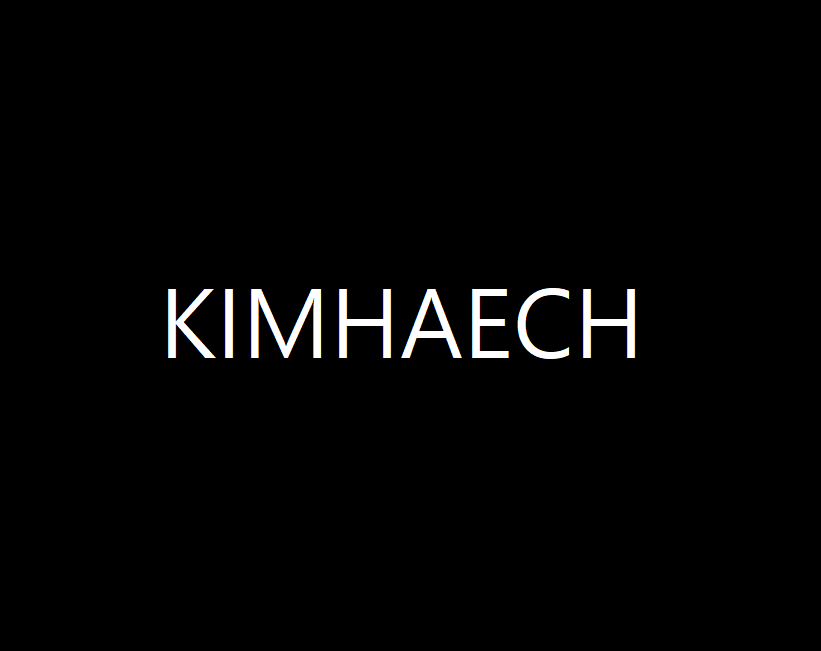210505 - 2
Selector
1.전체 셀렉터 (Universal Selector)

<!DOCTYPE html>
<html>
<head>
<style>
/* 모든 요소를 선택 */
* { color: red; }
</style>
</head>
<body>
<h1>Heading</h1>
<div>
<p>paragraph 1</p>
<p>paragraph 2</p>
</div>
<p>paragraph 3</p>
</body>
</html>2.태그 셀렉터(Type Selector)

지정된 태그명을 가지는 요소를 선택한다.
<!DOCTYPE html>
<html>
<head>
<style>
/* 모든 p 태그 요소를 선택 */
p { color: red; }
</style>
</head>
<body>
<h1>Heading</h1>
<div>
<p>paragraph 1</p>
<p>paragraph 2</p>
</div>
<p>paragraph 3</p>
</body>
</html>3.ID 셀렉터 (ID Selector)

<!DOCTYPE html>
<html>
<head>
<style>
/* id 어트리뷰트 값이 p1인 요소를 선택 */
#p1 { color: red; }
</style>
</head>
<body>
<h1>Heading</h1>
<div class="container">
<p id="p1">paragraph 1</p>
<p id="p2">paragraph 2</p>
</div>
<p>paragraph 3</p>
</body>
</html>4.클래스 셀렉터 (Class Selector)

<!DOCTYPE html>
<html>
<head>
<style>
/* class 어트리뷰트 값이 container인 모든 요소를 선택 */
/* color 어트리뷰트는 자식 요소에 상속된다. */
.container { color: red; }
/* not supported in IE */
#p2 { color: initial; }
</style>
</head>
<body>
<h1>Heading</h1>
<div class="container">
<p id="p1">paragraph 1</p>
<p id="p2">paragraph 2</p>
</div>
<p>paragraph 3</p>
</body>
</html>html요소에 class 어트리뷰트 값은 공백으로 구분하여 여러 개 지정할 수 있다. 클래스 셀렉터를 사용하여 미리 스타일을 정의해 두고, html 요소는 이미 정의되어 있는 클래스를 지정하는 것으로 필요한 스타일을 지정할 수 있다.
'재사용'의 측면에서 유용
<!DOCTYPE html>
<html>
<head>
<style>
/* class 어트리뷰트 값이 text-center인 모든 요소를 선택 */
.text-center { text-align: center; }
/* class 어트리뷰트 값이 text-large인 모든 요소를 선택 */
.text-large { font-size: 200%; }
/* class 어트리뷰트 값이 text-red인 모든 요소를 선택 */
.text-red { color: red; }
/* class 어트리뷰트 값이 text-blue인 모든 요소를 선택 */
.text-blue { color: blue; }
</style>
</head>
<body>
<p class="text-center">Center</p>
<p class="text-large text-red">Large Red</p>
<p class="text-center text-large text-blue">Center Large Blue</p>
</body>
</html>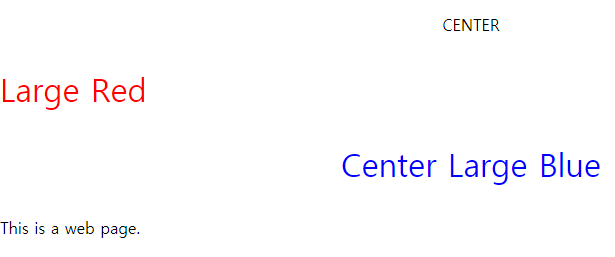
공백을 통해서 여러 개 지정한다.
위 코드에서 <p class="text-center text-large text-blue">는 center에 text를 두는 class 그리고 large, blue까지 적용이 된다.
5.어트리뷰트 셀렉터 (Attribute Selector)
셀렉터[어트리뷰트] - 지정된 어트리뷰트를 갖는 모든 요소를 선택
셀렉터[어트리뷰트=”값”] - 지정된 어트리뷰트를 가지며 지정된 값과 어트리뷰트의 값이 일치하는 모든 요소를 선택
셀렉터[어트리뷰트~=”값”] - 지정된 어트리뷰트의 값이 지정된 값을 (공백으로 분리된) 단어로 포함하는 요소를 선택
셀렉터[어트리뷰트|=”값”] - 지정된 어트리뷰트의 값과 일치하거나 지정 어트리뷰트 값 뒤 연이은 하이픈(“값-“)으로 시작하는 요소를 선택
셀렉터[어트리뷰트^=”값”] - 지정된 어트리뷰트 값으로 시작하는 요소를 선택
셀렉터[어트리뷰트$=”값”] - 지정된 어트리뷰트 값으로 끝나는 요소를 선택
셀렉터[어트리뷰트*=”값”] - 지정된 어트리뷰트 값을 포함하는 요소를 선택
<!DOCTYPE html>
<html>
<head>
<link rel="stylesheet" href="css/style.css">
</head>
<body>
<a href="http://www.naver.com">naver.com</a><br>
<a href="http://www.google.com">google.com</a><br>
<a href="http://daum.net" target="_blank">daum.net</a><br>
<h1 title="heading first">Heading first</h1>
<h1 title="headin-first">Heading-first</h1>
<p lang="en">Hello!</p>
<p lang="en-us">Hi!</p>
<p lang="en us">Hi!</p>
<a href="https://www.test.com">https://www.test.com</a><br>
<a href="http://www.test.com">http://www.test.com</a>
<a href="test.html">test.html</a><br>
<a href="test.jsp">test.jsp</a>
<div class="first_test">The first div element.</div>
<div class="second">The second div element.</div>
<div class="test">The third div element.</div>
<p class="test">This is some text in a paragraph.</p>
</body>
</html>css
/* a 요소 중에 href 어트리뷰트를 갖는 모든 요소 */
a[href] { color: red; }
/* a 요소 중에 target 어트리뷰트의 값이 "_blank"인 모든 요소 */
a[target="_blank"] { color: orange; }
/* h1 요소 중에 title 어트리뷰트 값에 "first"를 단어로 포함하는 요소(공백으로 분리) */
h1[title~="first"] { color: yellow; }
/* p 요소 중에 lang 어트리뷰트 값이 "en"과 일치하거나 "en-"로 시작하는 요소 */
p[lang|="en"] { color: green; }
/* a 요소 중에 href 어트리뷰트 값이 "https://"로 시작하는 요소 */
a[href^="https://"] { color: blue; }
/* a 요소 중에 href 어트리뷰트 값이 ".html"로 끝나는 요소 */
a[href$=".html"] { color: navy; }
/* div 요소 중에서 class 어트리뷰트 값에 "test"를 포함하는 요소 */
div[class*="test"] { color: violet; }
/* div 요소 중에서 class 어트리뷰트 값에 "test"를 단어로 포함하는 요소 */
div[class~="test"] { background-color: yellow; }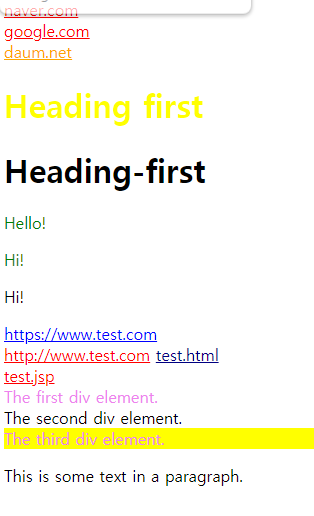
6.복합 셀렉터 (Combinator)
6.1 후손 셀렉터 (Descendant Combinator)
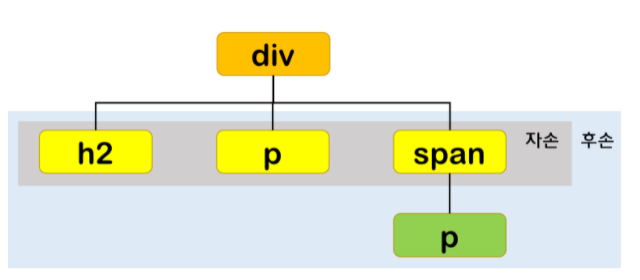
자신의 1 level 상위에 속하는 요소를 부모 요소, 1 level 하위에 속하는 요소를 자손 요소(자식 요소)라 한다.
자신보다 n level 하위에 속하는 요소는 후손 요소(하위 요소)라고 한다.
후손 셀렉터는 셀렉터A의 모든 후손(하위)요소 중 셀렉터B와 일치하는 요소를 선택한다.
셀렉터A 셀렉터B
<!DOCTYPE html>
<html>
<head>
<style>
/* div 요소의 후손요소 중 p 요소 */
div p { color: red; }
</style>
</head>
<body>
<h1>Heading</h1>
<div>
<p>paragraph 1</p>
<p>paragraph 2</p>
<span><p>paragraph 3</p></span>
</div>
<p>paragraph 4</p>
</body>
</html>6.2 자식 셀렉터 (Child Combinator)
자손 셀렉터는 셀렉터A의 모든 자식 요소 중 셀렉터B와 일치하는 요소를 선택한다.
셀렉터A > 셀렉터B
<!DOCTYPE html>
<html>
<head>
<style>
/* div 요소의 자식요소 중 p 요소 */
div > p { color: red; }
</style>
</head>
<body>
<h1>Heading</h1>
<div>
<p>paragraph 1</p>
<p>paragraph 2</p>
<span><p>paragraph 3</p></span>
</div>
<p>paragraph 4</p>
</body>
</html>6.3 형제(동위) 셀렉터 (Sibling Combinator)
형제 관계(동위 관계)에서 뒤에 위치하는 요소를 선택할 때 사용한다.
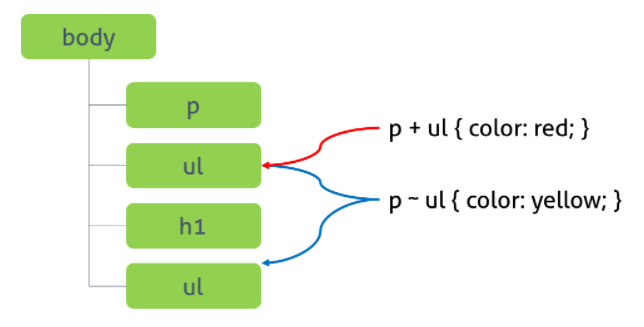
6.3.1 인접 형제 셀렉터(Adjacent Sibling Combinator)
셀렉터A의 형제 요소 중 셀렉터A 바로 뒤에 위치하는 셀렉터B 요소를 선택한다. A와 B사이에 다른 요소가 존재하면 선택되지 않는다.
셀렉터A + 셀렉터B
<!DOCTYPE html>
<html>
<head>
<style>
/* p 요소의 형제 요소 중에 p 요소 바로 뒤에 위치하는 ul 요소를 선택한다. */
p + ul { color: red; }
</style>
</head>
<body>
<div>A div element.</div>
<ul>
<li>Coffee</li>
<li>Tea</li>
<li>Milk</li>
</ul>
<p>The first paragraph.</p>
<ul>
<li>Coffee</li>
<li>Tea</li>
<li>Milk</li>
</ul>
<h2>Another list</h2>
<ul>
<li>Coffee</li>
<li>Tea</li>
<li>Milk</li>
</ul>
</body>
</html>6.3.2 일반 형제 셀렉터 (General Sibling Combinator)
셀렉터A의 형제 요소 중 셀렉터A 뒤에 위치하는 셀렉터B 요소를 모두 선택한다.
셀렉터A ~ 셀렉터B
<!DOCTYPE html>
<html>
<head>
<style>
/* p 요소의 형제 요소 중에 p 요소 뒤에 위치하는 ul 요소를 모두 선택한다.*/
p ~ ul { color: red; }
</style>
</head>
<body>
<div>A div element.</div>
<ul>
<li>Coffee</li>
<li>Tea</li>
<li>Milk</li>
</ul>
<p>The first paragraph.</p>
<ul>
<li>Coffee</li>
<li>Tea</li>
<li>Milk</li>
</ul>
<h2>Another list</h2>
<ul>
<li>Coffee</li>
<li>Tea</li>
<li>Milk</li>
</ul>
</body>
</html>7.가상 클래스 셀렉터 (Pseudo-Class Selector)
가상 클래스는 요소의 특정 상태에 따라 스타일을 정의할 때 사용된다. 특정 상태란 예를 들어 다음과 같다.
- 마우스가 올라와 있을때
- 링크를 방문했을 때와 아직 방문하지 않았을 때
- 포커스가 들어와 있을 때
이러한 특정 상태에는 원래 클래스가 존재하지 않지만 가상 클래스를 임의로 지정하여 선택하는 방법이다.
가상 클래스는 마침표(.) 대신 콜론(:)을 사용한다. CSS 표준에 의해 미리 정의된 이름이 있기 때문에 임의의 이름을 사용할 수 없다.
selector:pseudo-class {
property: value;
}<!DOCTYPE html>
<html>
<head>
<style>
/* a 요소가 hover 상태일 때 */
a:hover { color: red; }
/* input 요소가 focus 상태일 때 */
input:focus { background-color: yellow; }
</style>
</head>
<body>
<a href="#">Hover me</a><br><br>
<input type="text" placeholder="focus me">
</body>
</html>a요소가 hover상태(마우스가 올라와 있을 때) color를 red로 지정
input요소가 focus상태(셀렉터에 포커스가 들어와 있을 때) background-color를 yellow로 지정
7.1 링크 셀렉터(Link pseudo-classes), 동적 셀렉터 (User action pseudo-classes)

<!DOCTYPE html>
<html>
<head>
<style>
/* a 요소가 방문하지 않은 링크일 때 */
a:link { color: orange; }
/* a 요소가 방문한 링크일 때 */
a:visited { color: green; }
/* a 요소에 마우스가 올라와 있을 때 */
a:hover { font-weight: bold; }
/* a 요소가 클릭된 상태일 때 */
a:active { color: blue; }
/* text input 요소와 password input 요소에 포커스가 들어와 있을 때 */
input[type=text]:focus,
input[type=password]:focus {
color: red;
}
</style>
</head>
<body>
<a href="#" target="_blank">This is a link</a><br>
<input type="text" value="I'll be red when focused"><br>
<input type="password" value="I'll be red when focused">
</body>
</html>
-> a 요소를 클릭한 상태

-> input text 요소에 focus 상태
7.2 UI 요소 상태 셀렉터 (UI element states pseudo-classes)

<!DOCTYPE html>
<html>
<head>
<style>
/* input 요소가 사용 가능한 상태일 때,
input 요소 바로 뒤에 위치하는 인접 형제 span 요소를 선택 */
input:enabled + span {
color: blue;
}
/* input 요소가 사용 불가능한 상태일 때,
input 요소 바로 뒤에 위치하는 인접 형제 span 요소를 선택 */
input:disabled + span {
color: gray;
text-decoration: line-through;
}
/* input 요소가 체크 상태일 때,
input 요소 바로 뒤에 위치하는 인접 형제 span 요소를 선택 */
input:checked + span {
color: red;
}
</style>
</head>
<body>
<input type="radio" checked="checked" value="male" name="gender"> <span>Male</span><br>
<input type="radio" value="female" name="gender"> <span>Female</span><br>
<input type="radio" value="neuter" name="gender" disabled> <span>Neuter</span><hr>
<input type="checkbox" checked="checked" value="bicycle"> <span>I have a bicycle</span><br>
<input type="checkbox" value="car"> <span>I have a car</span><br>
<input type="checkbox" value="motorcycle" disabled> <span>I have a motorcycle</span>
</body>
</html>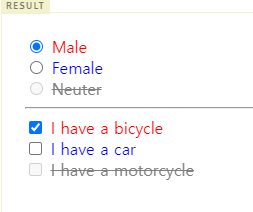
7.3 구조 가상 클래스 셀렉터 (Structural pseudo-classes)

<!DOCTYPE html>
<html>
<head>
<style>
/* p 요소 중에서 첫번째 자식을 선택 */
p:first-child { color: red; }
/* p 요소 중에서 마지막 자식을 선택 */
/* body 요소의 두번째 p 요소는 마지막 자식 요소가 아니다.
body 요소의 마지막 자식 요소는 div 요소이다. */
p:last-child { color: blue; }
</style>
</head>
<body>
<p>This paragraph is the first child of its parent (body).</p>
<h1>Welcome to My Homepage</h1>
<p>This paragraph is not the first child of its parent.</p>
<div>
<p>This paragraph is the first child of its parent (div).</p>
<p>This paragraph is not the first child of its parent.</p>
</div>
</body>
</html>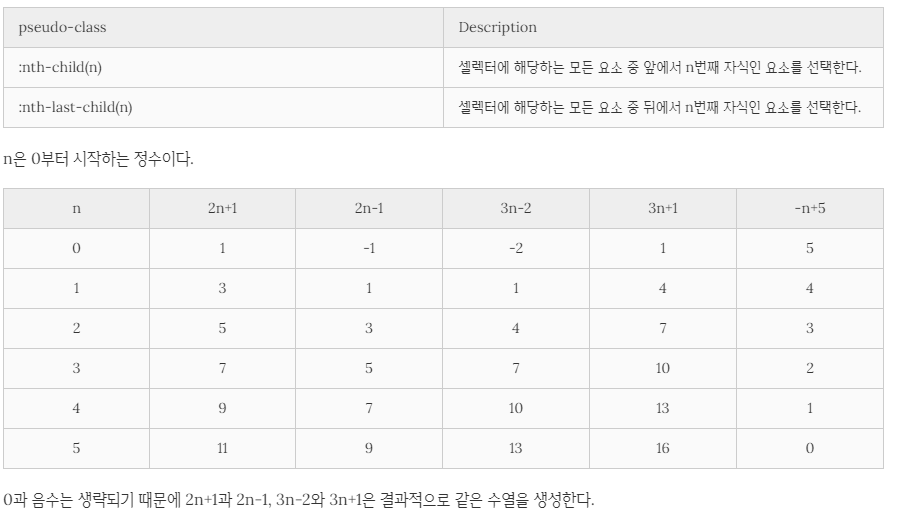
<!DOCTYPE html>
<html>
<head>
<style>
/* ol 요소의 자식 요소인 li 요소 중에서 짝수번째 요소만을 선택 */
ol > li:nth-child(2n) { color: orange; }
/* ol 요소의 자식 요소인 li 요소 중에서 홀수번째 요소만을 선택 */
ol > li:nth-child(2n+1) { color: green; }
/* ol 요소의 자식 요소인 li 요소 중에서 첫번쨰 요소만을 선택 */
ol > li:first-child { color: red; }
/* ol 요소의 자식 요소인 li 요소 중에서 마지막 요소만을 선택 */
ol > li:last-child { color: blue; }
/* ol 요소의 자식 요소인 li 요소 중에서 4번째 요소 요소만을 선택 */
ol > li:nth-child(4) { background: brown; }
/* ul 요소의 모든 자식 요소 중에서 뒤에서부터 시작하여 홀수번째 요소만을 선택 */
ul > :nth-last-child(2n+1) { color: red; }
/* ul 요소의 모든 자식 요소 중에서 뒤에서부터 시작하여 짝수번째 요소만을 선택 */
ul > :nth-last-child(2n) { color: blue; }
</style>
</head>
<body>
<ol>
<li>Espresso</li>
<li>Americano</li>
<li>Caffe Latte</li>
<li>Caffe Mocha</li>
<li>Caramel Latte</li>
<li>Cappuccino</li>
</ol>
<ul>
<li>Espresso</li>
<li>Americano</li>
<li>Caffe Latte</li>
<li>Caffe Mocha</li>
<li>Caramel Latte</li>
<li>Cappuccino</li>
</ul>
</body>
</html>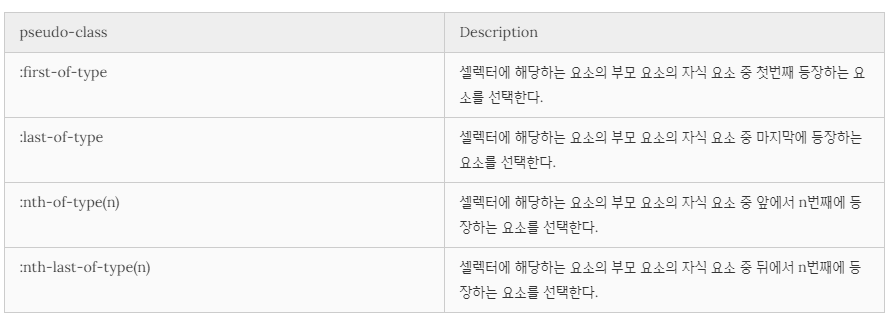
<!DOCTYPE html>
<html>
<head>
<style>
/* p 요소의 부모 요소의 자식 요소 중 첫번째 등장하는 p 요소 */
p:first-of-type { color: red; }
/* p 요소의 부모 요소의 자식 요소 중 마지막 등장하는 p 요소 */
p:last-of-type { color: blue; }
/* p 요소의 부모 요소의 자식 요소 중 앞에서 2번째에 등장하는 p 요소 */
p:nth-of-type(2) { color: green; }
/* p 요소의 부모 요소의 자식 요소 중 뒤에서 2번째에 등장하는 p 요소 */
p:nth-last-of-type(2) { color: orange;}
/* p 요소 중에서 첫번째 자식을 선택 */
p:first-child { background: brown;}
</style>
</head>
<body>
<h1>This is a heading</h1>
<p>The first paragraph.</p>
<p>The second paragraph.</p>
<p>The third paragraph.</p>
<p>The fourth paragraph.</p>
<div>
<h1>This is a heading</h1>
<p>The first paragraph.</p>
<p>The second paragraph.</p>
<p>The third paragraph.</p>
<p>The fourth paragraph.</p>
</div>
</body>
</html>7.4 부정 셀렉터 (Negation pseudo-class)

<!DOCTYPE html>
<html>
<head>
<style>
/* input 요소 중에서 type 어트리뷰트의 값이 password가 아닌 요소를 선택 */
input:not([type=password]) {
background: yellow;
}
</style>
</head>
<body>
<input type="text" value="Text input">
<input type="email" value="email input">
<input type="password" value="Password input">
</body>
</html><!DOCTYPE html>
<html>
<head>
<style>
body {
margin: 0;
}
div {
float: left;
width: 32%;
height: 200px;
background-color: red;
/* margin-bottom: 2%; */
color: #fff;
font-size: 3em;
line-height: 200px;
text-align: center;
}
/* div 요소 중에서 1, 4, 7...번째 등장하는 요소가 아닌 요소만을 선택 */
/* 1, 4, 7... : 공차가 3인 등차수열 */
div:not(:nth-of-type(3n+1)) {
margin-left: 2%;
}
/* div 요소 중에서 4번째 이후 등장하는 요소가 아닌 요소만을 선택 */
div:not(:nth-of-type(n+4)) {
margin-bottom: 2%;
}
</style>
</head>
<body>
<div>1</div>
<div>2</div>
<div>3</div>
<div>4</div>
<div>5</div>
<div>6</div>
</body>
</html>7.5 정합성 체크 셀렉터 (validity pseudo-class)

<!DOCTYPE html>
<html>
<head>
<style>
input[type="text"]:valid {
background-color: greenyellow;
}
input[type="text"]:invalid {
background-color: red;
}
</style>
</head>
<body>
<label>입력값이 반드시 필요
<input type="text" required>
</label>
<br>
<label>특수문자를 포함하지 않는 4자리 문자 또는 숫자
<input type="text" value="ab1!"
pattern="[a-zA-Z0-9]{4}" required>
</label>
<br>
<label>핸드폰 번호 형식
<input type="text" value="010-1111-2222"
pattern="^\d{3}-\d{3,4}-\d{4}$" required>
</label>
</body>
</html>8.가상 요소 셀렉터 (Pseudo-Element Selector)
가상 요소는 요소의 특정 부분에 스타일을 적용하기 위하여 사용된다. 특정 부분이란 예를 들어 다음과 같다.
- 요소 콘텐츠의 첫글자 또는 첫줄
- 요소 콘텐츠의 앞 또는 뒤
가상 요소에는 두개의 콜론(::)을 사용. CSS표준에 의해 미리 정의된 이름이 있기 때문에 임의의 이름을 사용할 수 없다.
selector::pseudo-element {
property:value;
}
<!DOCTYPE html>
<html>
<head>
<style>
/* p 요소 콘텐츠의 첫글자를 선택 */
p::first-letter { font-size: 3em; }
/* p 요소 콘텐츠의 첫줄을 선택 */
p::first-line { color: red; }
/* h1 요소 콘텐츠의 앞 공간에 content 어트리뷰트 값을 삽입한다 */
h1::before {
content: " HTML!!! ";
color: blue;
}
/* h1 요소 콘텐츠의 뒷 공간에 content 어트리뷰트 값을 삽입한다 */
h1::after {
content: " CSS3!!!";
color: red;
}
/* 드래그한 콘텐츠를 선택한다 */
::selection {
color: red;
background: yellow;
}
</style>
</head>
<body>
<h1>This is a heading</h1>
<p>Lorem ipsum dolor sit amet, consectetur adipisicing elit. Explicabo illum sunt distinctio sed, tempore, repellat rerum et ea laborum voluptatum! Quisquam error fugiat debitis maiores officiis, tenetur ullam amet in!</p>
</body>
</html>